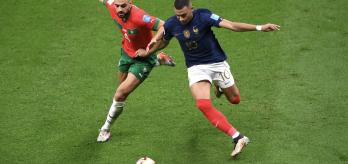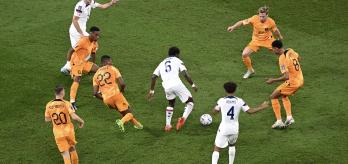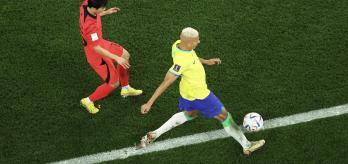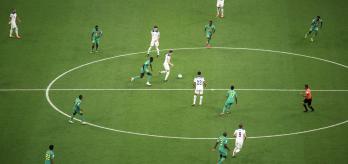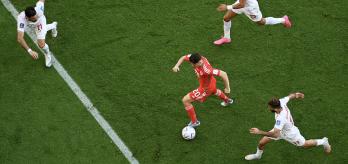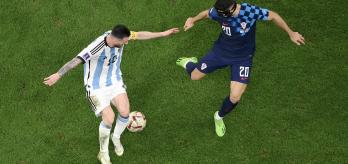Key points
-
Spain covered the most overall distance with the ball, and the likes of Costa Rica and Japan covered the most without the ball. Meanwhile, the USA covered the most distance at higher intensities with the ball and Saudi Arabia covered the most distance without the ball.
-
Sprint distance was 6-19% higher in the FIFA World Cup™ final compared to other stages of the tournament.
-
No associations existed between the physical metrics and the percentage of wins that teams attained in the FIFA World Cup Qatar 2022™. However, five of the eight quarter-finalists (Argentina, France, Brazil, England and Portugal) covered substantial sprint distances with the ball.
FACTORS IMPACTING TEAM PHYSICAL PERFORMANCES
As football is a team sport that is highly technical, tactical and psychological, it is not surprising that numerous factors can impact the physical outputs of teams1. Although these factors are countless, they include possession status, opposition standard, competition stage, scoreline, match location, fatigue, formation and style of play2. Understanding these influences can allow practitioners to fully grasp the sheer complexity surrounding these factors and how they collide when teams play various matches across a tournament such as the FIFA World Cup Qatar 2022™. Thus, this section will delve into "how" the team’s physical demands change in relation to some of these varied contexts.
DISTANCES COVERED WITH AND WITHOUT THE BALL
Previously, this analysis evaluated "what" distances teams covered but it is also informative to look at "how" these distances were covered (e.g. with or with out the ball). Figure 1 segments the total distance covered into a team’s possession status. This reveals that Spain, perhaps unsurprisingly, covered the most overall distance with the ball and that the likes of Costa Rica and Japan covered the most overall distance without the ball. Interestingly, Spain dominated ball possession against both Costa Rica and Japan, thus directly contributing to their opponents’ extreme out-of-possession distances. In fact, Japan had only 18% ball possession when they beat Spain 2-1, which is the lowest ball possession statistic for a winning team in FIFA World Cup™ history.
Figures 2 and 3 demonstrate that the USA covered the most distance at higher intensities (>20km/h and >25km/h) with the ball and that Saudi Arabia covered the most distance without the ball. The USA’s elevated high-intensity distance with the ball is probably due to their high number of movements to receive, progressions and final-third entries, which required them to cover ground at high speed. In contrast, Saudi Arabia had to cover more high-intensity distance without the ball than other teams due to frequent turnovers requiring them to counter-press, defensively transition and recover rapidly.
DISTANCES COVERED ACROSS STAGES OF TOURNAMENT
As teams progress through the group stage to the knockout stages, more importance is placed on winning. This added incentive to win in the knockout stages has been found to increase the tempo of match play. For instance, in the FIFA Women’s World Cup Canada 2015™ and France 2019™, the distance covered in the highest speed zone increased by 8-12% in the knockout stage compared to the group stage3. For the FIFA World Cup Qatar 2022, no such trends were evident for the distances covered in total and at high intensity (>20km/h) across various stages of the tournament or for the teams that actually progressed through each stage (Figures 4 and 5).
However, in the World Cup final, the distance covered while sprinting (>25km/h) was 6-19% higher than in all other stages of the tournament (Figure 6). Moreover, the two finalists (Argentina and France) produced their highest sprint outputs of the whole tournament in the final. This is particularly relevant given that these two teams were ranked 12th and 17th on the sprint metric out of the 32 teams. This demonstrates that the tempo of match play may be at its highest as teams approach the business end of a tournament.
QUADRANT PLOTS: PHYSICAL METRICS VERSUS WINNING
As winning becomes more important as teams move through the tournament, it might be prudent to ask: are higher physical outputs associated with winning? Figures 7-10 illustrate that there is no positive association between the physical metrics and the percentage of wins that teams attained in the FIFA World Cup Qatar 2022. For the total distance covered metric, only one quarter-finalist can be found in the upper-right quadrant (high distance, high win %).
However, as we progress to high-intensity (>20km/h), sprinting (>25km/h) and then sprinting with the ball, there are five quarter-finalists (Argentina, France, Brazil, England and Portugal) in the upper-right quadrant. In fact, World Cup winners Argentina were the highest team in the upper-left quadrant for total distance covered (low distance, high win %), but as one moves through the intensities, they eventually end up as the highest team in the upper-right quadrant for the distance covered while sprinting with the ball (high sprint distance with the ball, high win %). This potentially indicates the sensitivity of the sprinting with the ball metric for successful teams, although more research is needed to confirm this.
IMPACT OF CONFEDERATION AND PLAYING FORMATION ON PHYSICAL PERFORMANCES
In Qatar, teams representing Concacaf and the AFC covered 1-5% more total distance, 4-8% more high-intensity distance and 4-11% more sprint distance than teams representing CAF, UEFA and CONMEBOL because Concacaf and the AFC were represented by some of the teams with the highest physical outputs (e.g. USA, Canada, Saudi Arabia, IR Iran). Interestingly, CONMEBOL teams covered the lowest distances in total and at high intensity (>20km/h), but for sprint distances (>25km/h) they jumped from fifth to third place, once again potentially highlighting sprinting as a sensitive metric as world champions Argentina represented this confederation (data not displayed).
Finally, the most popular playing formations in the FIFA World Cup Qatar 2022 did not substantially impact the physical outputs of teams. Teams employing a 4-3-3 or a 4-2-3-1 system covered around 1-3% more distance at high intensity (>20km/h) and 4-7% more sprinting (>25km/h) than those utilising a 4-4-2 or 3-4-3 system (data not displayed), although the huge variation in physical outputs across most tactical systems probably limits any practical application that can be drawn from this section of the analysis.
References
-
Bradley PS. Football Decoded: Using Match Analysis & Context to Interpret the Demands. 2020, Amazon, UK.
-
Paul DJ, Bradley PS, Nassis GP. Factors affecting match running performance of elite soccer players: shedding some light on the complexity. International Journal of Sports Physiology and Performance. 2015, 10: 516-519.
-
Bradley PS, Scott D. Physical Analysis of the FIFA Women’s World Cup France 2019™. 2020, Zurich: FIFA. Available from: https://digitalhub.fifa.com/m/4f40a98140d305e2/original/zijqly4oednqa5gffgaz-pdf.pdf. [accessed March 2023]










